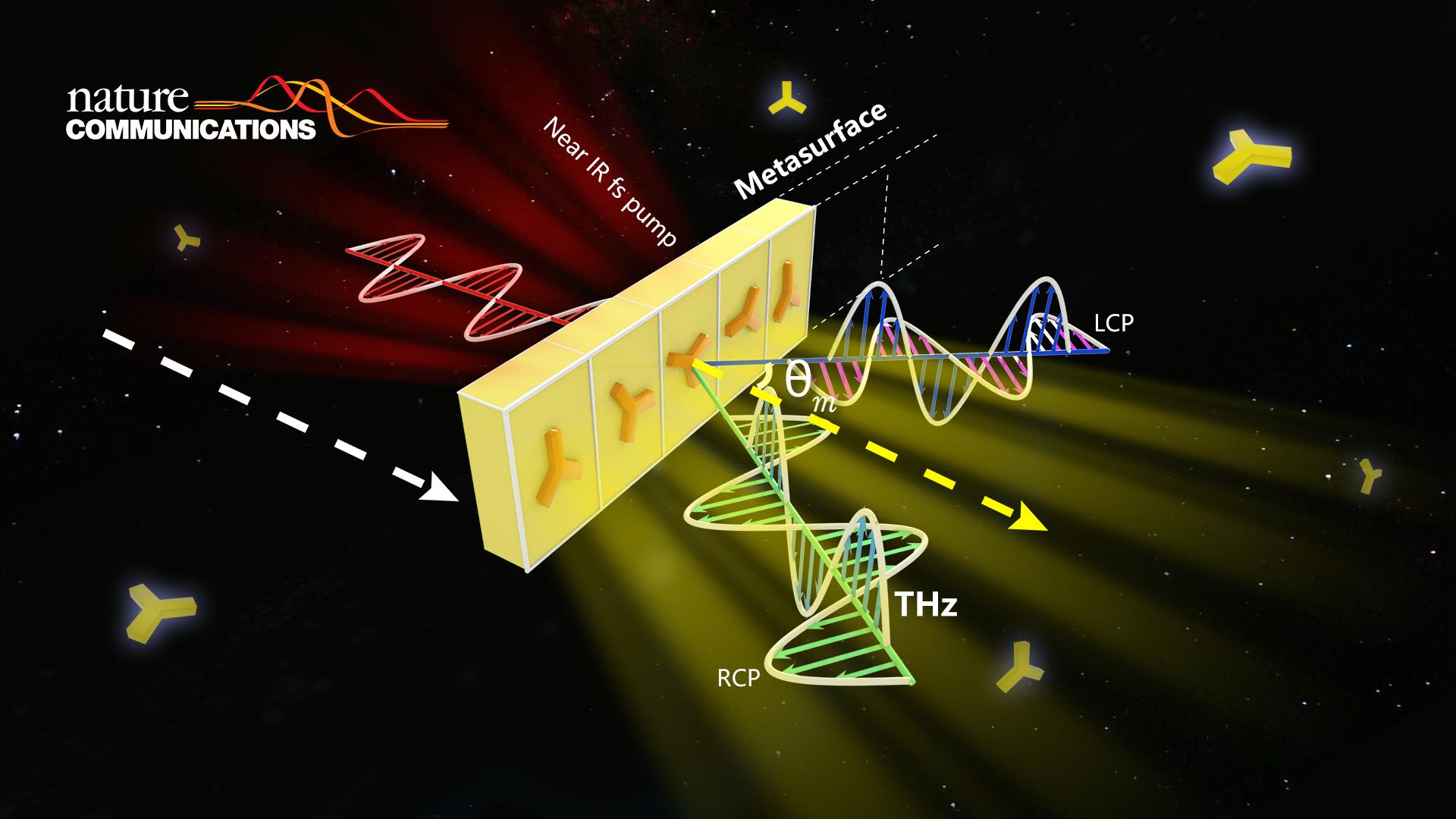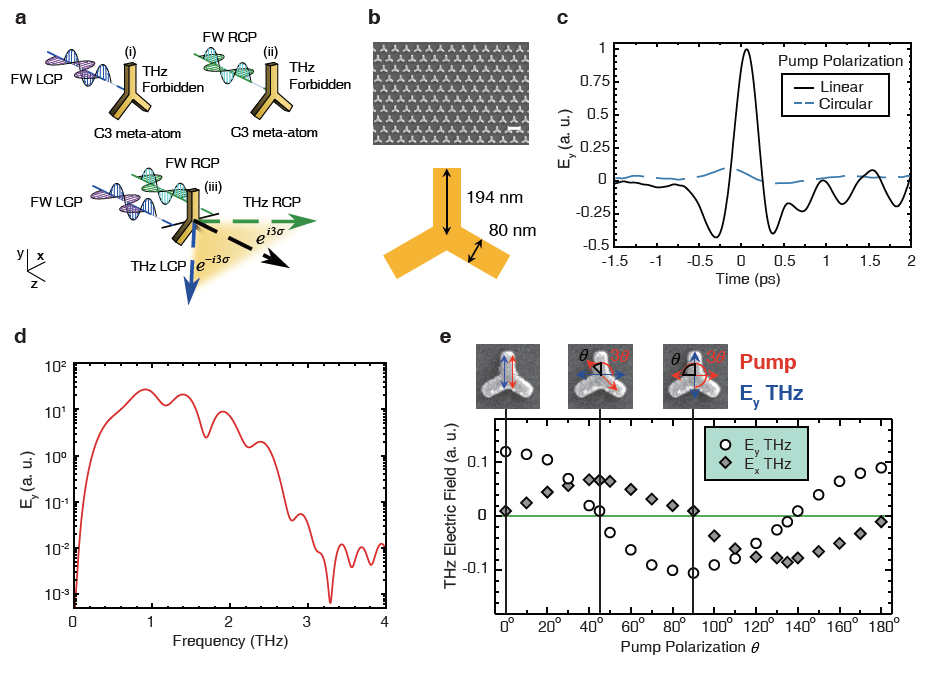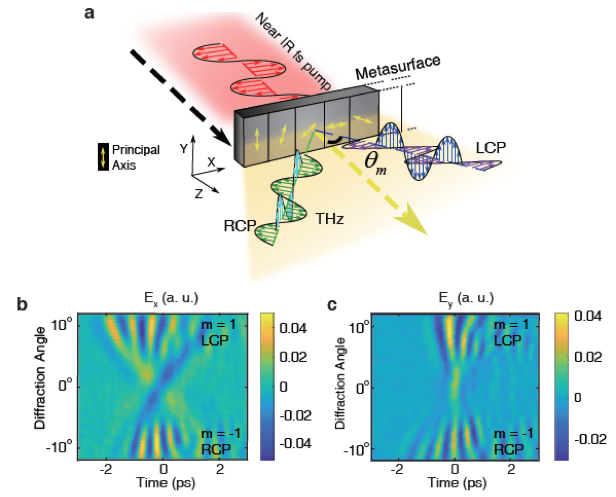Recent advances in the science and technology of THz waves show promise for a wide variety of important applications in material inspection, imaging, biomedical science, and so on. However, this promise is impeded by the lack of sufficiently functional THz emitters.

On January 4, Associate Professor Guixin Li led an international research team (SUSTech and Tel-Aviv University) to publish the progress of their research in the high-impact academic journal, Nature Communications. The paper titled “Functional THz Emitters based on Pancharatnam-Berry Phase Nonlinear Metasurfaces.” proposed a broadband THz emitter based on Pancharatnam-Berry phase nonlinear metasurfaces, which exhibit unique optical functionalities. Using these new emitters, they experimentally demonstrated tunable linear polarization of broadband single-cycle THz pulses, the splitting of spin states and THz frequencies in the spatial domain, and the generation of few-cycle pulses with temporal polarization dispersion. Finally, they applied the ability of spin control of THz waves to demonstrate circular dichroism spectroscopy of amino acids. Altogether, nanoscale and all-optical control over the phase and polarization states of the emitted THz waves were achieved.
Increasing numbers of important industrial and scientific applications aim to employ terahertz (THz) electromagnetic waves. Their relatively low energies allow probing of vibrionic and rotational transitions in molecules, which makes them useful to remotely identify a wide variety of material compositions and structures. Furthermore, their penetration into optically opaque materials can be applied to the remote inspection of concealed areas for security or inspecting circuits in electronic devices, and even studying hidden layers in paintings. Therefore, over the past three decades, a great amount of research has been devoted to the science and technology of THz waves. These efforts have advanced the ability to generate, control, and detect THz waves through numerous methods. Yet, state-of-the-art THz emitters still do not have the capabilities and functionalities of their counterparts in the radio frequency, microwave, and optical regimes. This limitation has strongly frustrated the widespread deployment of emerging THz technologies and their applications.
They demonstrate a new kind of metasurface-based THz emitter, in which both the polarization and phase of THz waves can be finely controlled by using the concept of geometric Pancharatnam-Berry (P-B) phase, in the nonlinear optical regime. The building block of the proposed emitter is a nanoscale gold plasmonic meta-atom, which has three-fold (C3) rotational symmetry. They show that under illumination with fundamental waves both left and right circular polarizations (LCP and RCP), and the C3 meta-atom emits THz waves with spin-dependent geometric phases. Unlike the nonlinear geometric P-B phase demonstrated in harmonic generation processes, in which the polarization states of fundamental waves can be either LCP or RCP, here the fundamental waves must contain both circular polarization states, which allows excitation with linearly polarized light. Using spatially variant meta-atoms on the plasmonic metasurface, the phase and polarization of the THz waves can be controlled at a deep-subwavelength scale. This enables the realization of THz emitters with exciting new functionalities as demonstrated below.

Figure 1. Symmetry selection rules for THz wave generation using C3 meta-atoms. (A) Symmetry selection rules for generating THz pulses from a C3 meta-atom. (B) C3 Meta-atom dimensions, and sample orientation. Scale bar = 550 nm. (C) Generation of a single cycle THz pulse. (D) Corresponding frequency spectrum of the generated THz pulse. (E) The detected Ey and Ex components of the THz field.

Figure 2. Spin-orbit interaction for THz waves. (A) Schematic illustration of a 1 mm section of the metasurface for the generation of spatially separated LCP and RCP THz waves. (B) Ex and (C) Ey components of the THz temporal fields after NIR pumping.
Considering quadratic nonlinear interaction, they show that mutual interaction of the two spin states of the pump waves is essential to generate and manipulate the broadband THz waves. This understanding of the use of nonlinear P-B phase for THz generation allows unprecedented control over the polarization and phase of the THz wave-packet. This work immediately suggests a plethora of new roles for the nonlinear P-B phase in THz science and its applications.
Dr. Cormac McDonnell, a postdoctoral researcher at Tel-Aviv University, and Dr. Junhong Deng, a research assistant professor at the Shenzhen Institute for Science and Engineering of SUSTech, are the co-first authors of the paper. Guixin Li from the Department of Materials Science and Engineering of SUSTech and Professor Tal Ellenbogen from Tel-Aviv University are the corresponding authors. Symeon Sideri, a Ph.D. student at Tel Aviv University, also made important contributions to the research. G. L. was financially supported by the National Natural Science Foundation of China, Guangdong Provincial Innovation and Entrepreneurship Project.
Paper link: https://www.nature.com/articles/s41467-020-20283-0






